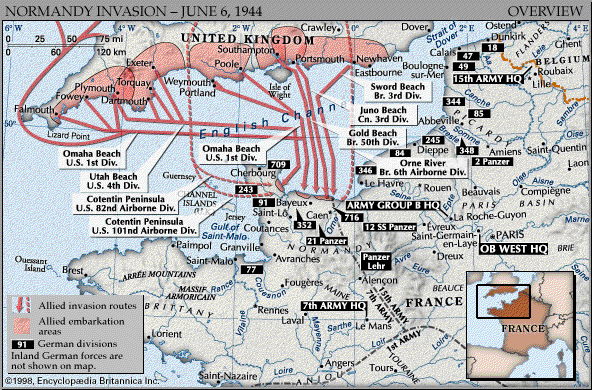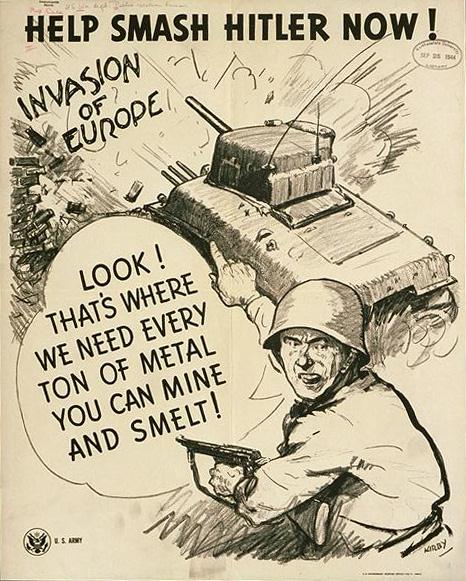|
|
 |
|

The D-Day operation of June 6, 1944 brought together the land, air and sea forces of the allied armies in what
became known as the largest invasion force in human history. The operation, given the codename OVERLORD, delivered five
naval assault divisions to the beaches of Normandy, France. The beaches were given the codenames UTAH, OMAHA, GOLD,
JUNO and SWORD. The invasion force included 7,000 ships and landing craft manned by over 195,000 naval personnel from eight
allied countries. Almost 133,000 troops from England, Canada and the United States landed on D-Day. Casualties
from the three countries during the landing numbered 10,300. By June 30th, over 850,000 men, 148,000 vehicles, and 570,000
tons of supplies had landed on the Normandy shores. Fighting by the brave soldiers, sailors and airmen of the allied forces
western front and Russian forces on the eastern front led to the defeat of German Nazi forces. On May 7, 1945, German
General Alfred Jodl signed an unconditional surrender at Reims, France.
|
 |
|
A brief summary of the invasion:
At the beginning of World War 2, Germany invaded
Poland, causing France, Great Britain and Canada to declare war on Germany. By the spring of 1940, the German army was ready
to invade France, defended by not only the French military, but also a sizable British force as well. Within six weeks, the
Germans defeated the Allies and seized control of France. By 1944, the Germans knew that the Allies, also now including the
United States, among others, would attempt an invasion of France to liberate Europe from Germany. The Allied forces, based
in Britain, decided to begin the invasion by landing a huge army at a place called Normandy Beach, which is located on the
northwest coast of France. Code-named "Operation Overlord", and commanded by American General Dwight D. Eisenhower, the Allies
landed on June 6, 1944 at five beaches in the Normandy area with the code names of: Utah Beach, Omaha Beach, Gold Beach, Juno
Beach and Sword Beach. Prior to the actual amphibious invasion, Allied planes pounded the Nazi defenders and dropped thousands
of paratroopers behind German lines the night before the seaborne landings. Local French Resistance forces, alerted to the
imminent invasion, engaged in behind-the-lines sabotage and combat against the occupying Germans.
156,000 American, British and Canadian troops met heavy resistance from
the German forces defending the area, but were able to punch inland, securing safe landing zones for reinforcements. The German
failure to successfully defend the Normandy area from the Allied liberation forces in essence doomed Hitler's dream of a Nazi
controlled "Fortress Europe" and marked the beginning of the end for Germany.
The entire purpose of the Invasion was to acheive complete victory over the German threat in France. The people
who fought on the beaches were ordianry people with and extraordinary task. Stories of heroism and honor fill the hearts of
many soldiers and graves sites today.

|
| Actual poster that was displayed during WWII |
|
 |
|
|
 |
|
About Creators..
Trevor and Blake are both 16 years old, muscular, and single. We enjoy long walks in the warm summer months with
other young people...haha just kiddin. But really.
Site last updated on 3-17-2005
|
 |
|
|
|
|
|
|
 |

